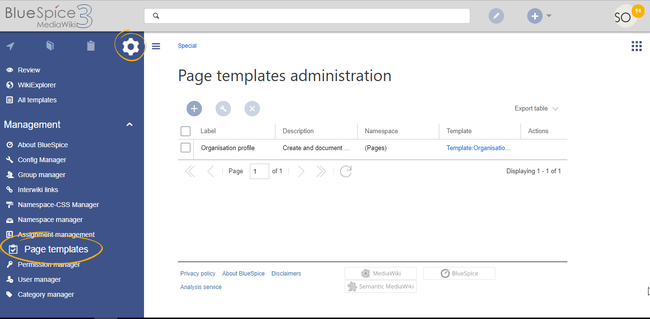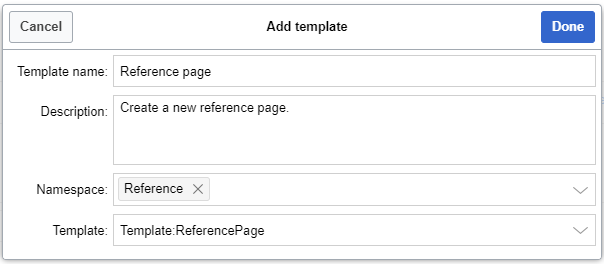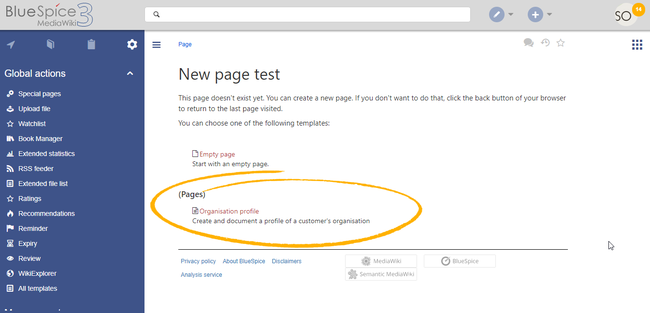Difference between revisions of "Manual:Extension/BlueSpicePageTemplates"
| [quality revision] | [quality revision] |
(Tag: 2017 source edit) |
(Tag: 2017 source edit) |
A page template applies a predefined content structure and layout to new pages. That way, certain page types can be applied during page creation to produce consistent sets of related pages.
Contents
CharacteristicsWhen to use page templates[edit | edit source]
Page templates are especially useful for frequently used content formats such as logsmeeting minutes, reference pages, product descriptions, or short manuals. When a page is created with a page template, the page becomes "detached" from the original page template. This means that subsequent changes to the template will not affect pages that have originally been created with that page template. This distinguishes page templates from regular templates.
In gerneral, page templates:
Characteristics of a page template[edit | edit source]
- can be created by administrators
- can only be used for new pages
- are based on templates in the Template namespaces
- can be limited to certain namespaces
- substitution of variables is possible
- can integrate with the extension Page Forms
Creating a page template[edit | edit source]
Administrators can create new page templates, as well as edit and remove existing ones in the Page templates manager, located under Global actions.
Note: Every page template depends on an actual page in the namespace Template. This template must exist before creating a page template.
A new page template can be created by clicking the "Plus" button above the template list.
Template fields[edit | edit source]
When creating or editing a page template, the following information needs to be provided:
- Name - the name of the template
- Description - a short description of the template
- Namespace - list of the namespace where the template is active
- Template - page from the Template namespace from which to pull the data
Using page templates[edit | edit source]
A list of available templates appears when a user creates a new page. It is shown below the "Empty page" default template. Selecting one of these page templates will create the new page that is prefilled with the content that is transcluded from the actual template page.
Configuration[edit | edit source]
In the Config manager, you can change the following settings:
- Force target namespace:
- Hide default templates: Hides the default Empty page template.
Related info
{{DISPLAYTITLE:Page templates}}
<section begin="training-intro" />
A page template applies a predefined content structure and layout to new pages. That way, certain page types can be applied during page creation to produce consistent sets of related pages.
==Characteristics==
Page templates are especially <section eind="training-intro" />
==When to use page templates==
<section begin="training-intro" />
Page templates are useful for frequently used content formats such as logsmeeting minutes, reference pages, product descriptions, or short manuals.<section end="training-intro" /> When a page is created with a page template, the page becomes "detached" from the original page template. This means that subsequent changes to the template will not affect pages that have originally been created with that page template. This distinguishes page templates from regular [[templates]].
In gerneral, page templates:
*used for new pages only
*can be limited to certain namespaces
*can force a namespace for new pages
*are === Characteristics of a page template ===
<section begin="training" />
*can be created by administrators
*can only be used for new pages
*based on templates in the ''Template'' namespaces
*can be limited to certain namespaces
*substitution of variables is possible
*can integrate with the extension [[Reference:''Page Forms|Page Forms]]
''
<section end="training" />
==Creating a page template==
Administrators can create new page templates, as well as edit and remove existing ones in the ''Page templates'' manager, located under ''Global actions''.
<br />
[[File:PageTemplates1a.png|Page template manager|link=https://en.wiki.bluespice.com/wiki/File:PageTemplates1a.png|center|650x650px|alt=Page template manager|thumb]]{{Box Note|boxtype=note|Note text=Every page template depends on an actual page in the namespace Template. This template must exist before creating a page template.}}
A new page template can be created by clicking the "Plus" button above the template list.
===Template fields===
When creating or editing a page template, the following information needs to be provided:
*'''Name''' - the name of the template
*'''Description''' - a short description of the template
*'''Namespace''' - list of the namespace where the template is active
*'''Template''' - page from the Template namespace from which to pull the data
[[File:PageTemplates2.png|link=https://en.wiki.bluespice.com/wiki/File:PageTemplates2.png|alt=Screenshot: update page template settings|border|center|650x650px]]
<br />
==Using page templates==
A list of available templates appears when a user creates a new page. It is shown below the "Empty page" default template. Selecting one of these page templates will create the new page that is prefilled with the content that is transcluded from the actual template page.
<br />
[[File:PageTemplates3a.png|Selecting a page template|link=https://en.wiki.bluespice.com/wiki/File:PageTemplates3a.png|alt=Selecting a page template|center|650x650px|thumb]]
==Configuration==
In the [[Manual:Extension/BlueSpiceConfigManager|Config manager]], you can change the following settings:
{{#dpl:title=Manual:Extension/BlueSpiceConfigManager|include=#BlueSpicePageTemplates}}
{{Box Links-en|Topic1=[[Reference:BlueSpicePageTemplates]]}}
[[en:{{FULLPAGENAME}}]]
[[de:Handbuch:Erweiterung/BlueSpicePageTemplates]]
[[Category:Organization]]| Line 1: | Line 1: | ||
{{DISPLAYTITLE:Page templates}} | {{DISPLAYTITLE:Page templates}} | ||
| − | + | <section begin="training-intro" /> | |
A page template applies a predefined content structure and layout to new pages. That way, certain page types can be applied during page creation to produce consistent sets of related pages. | A page template applies a predefined content structure and layout to new pages. That way, certain page types can be applied during page creation to produce consistent sets of related pages. | ||
| + | <section eind="training-intro" /> | ||
| + | ==When to use page templates== | ||
| + | <section begin="training-intro" /> | ||
| + | Page templates are useful for frequently used content formats such as meeting minutes, reference pages, product descriptions, or short manuals.<section end="training-intro" /> When a page is created with a page template, the page becomes "detached" from the original page template. This means that subsequent changes to the template will not affect pages that have originally been created with that page template. This distinguishes page templates from regular [[templates]]. | ||
| − | ==Characteristics== | + | === Characteristics of a page template === |
| − | + | <section begin="training" /> | |
| − | + | *can be created by administrators | |
| − | + | *can only be used for new pages | |
| − | + | *based on templates in the ''Template'' namespaces | |
| − | *used for new pages | ||
*can be limited to certain namespaces | *can be limited to certain namespaces | ||
| − | * | + | *substitution of variables is possible |
| − | + | *can integrate with the extension ''Page Forms'' | |
| − | *integrate with the extension | + | <section end="training" /> |
| − | |||
==Creating a page template== | ==Creating a page template== | ||
Administrators can create new page templates, as well as edit and remove existing ones in the ''Page templates'' manager, located under ''Global actions''. | Administrators can create new page templates, as well as edit and remove existing ones in the ''Page templates'' manager, located under ''Global actions''. | ||


